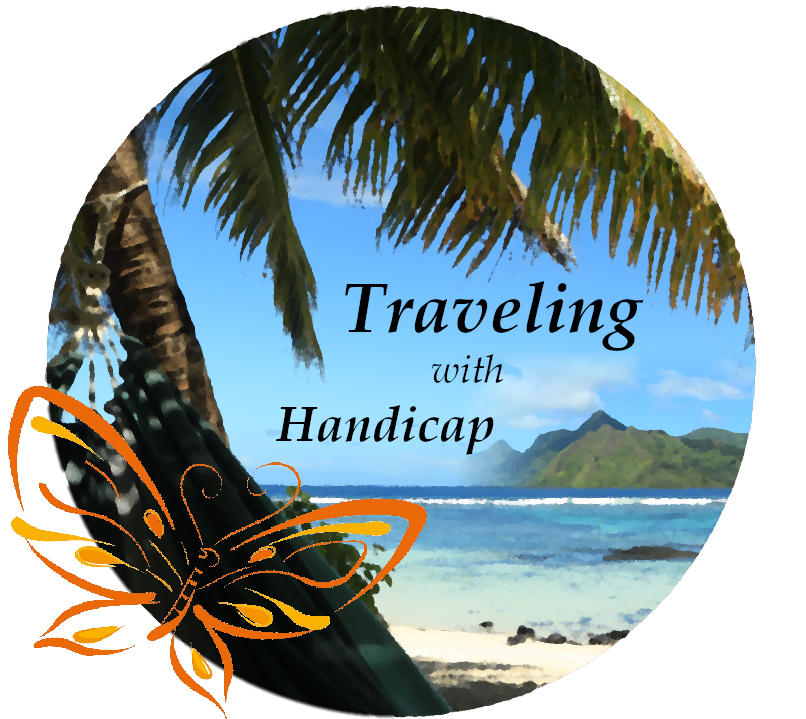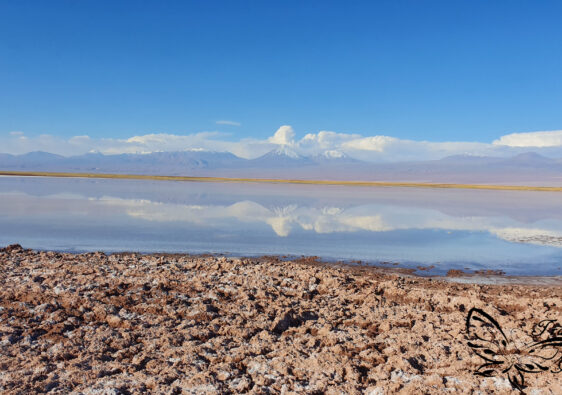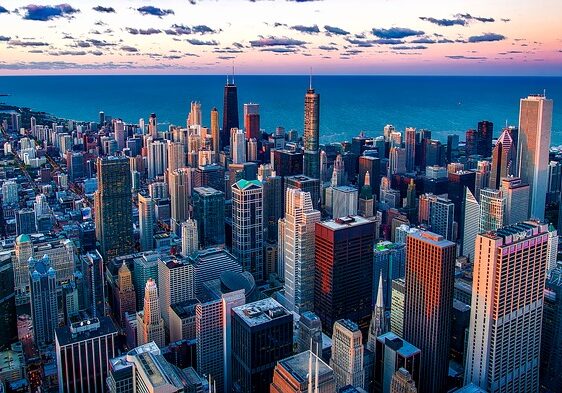Live with no excuses and travel with no regrets.
— Oscar Wilde —
Touring around Mongolia by an organized tour
Finding a tour provider
Right after exiting the train at the Ulaanbaatar station, I was approached by many people trying to sell their tours across all Mongolia. The standard question was whether I already have any plans, and the immediate answer that they know best what I should do. Well, these people did not know about the recommendation I got from a Dutch girl who I met in Andong, South Korea. This girl recommended the tours by Sunpath Mongolia from her own experience. Moreover, I’ve had this tour provider on my prepared list of well-rated value for money agencies.
Talking to other tourists in Mongolia, I figured out that many hostels claim to offer tours. However, many of these want you to find your travel companions by yourself. As soon as you have your group of people and a desired destination, they organize you a driver with a car. Keep in mind that there are too many agencies within Ulaanbaatar to keep track of the good ones. Therefore, I recommend to check TripAdvisor for agencies having quite old reviews. It’s a good sign if they already exist for years. Then, check out the quality and pricing of that subgroup according to your expectations.
The tour by Sunpath Mongolia
After arriving at the hostel, the owner introduced me to different options including the “12 days Gobi and Central Mongolia Tour” (naming of 2019) starting the next day in the morning. Currently, the tour with the highest similarity to my tour is the “Gobi and Hot Spring Tour”. The tour consisted of some spots within the famous Gobi Desert and other places within Central Mongolia. Within this post, I am talking about my unforgettable experiences in the Gobi Desert. The calm, peaceful and powerful atmosphere of Central Mongolia is part of another article.
We were a group of 7 tourists, consisting of 3 Germans, one Malaysian, one Italian and two French people. We were transported in old Russian vans, which were surprisingly stable. For the seven of us, we required two vans with drivers each. As soon as a tour needs more than one van, not only a tour guide but also a chef joins the tour. Three of us ended the tour after the days in the Gobi, since they had to go back to Ulaanbaatar for pre-booked international connections. They went back on one van, including the chef.
Food provided during the tour
Sunpath was very careful regarding our eating habits and requirements. We have been asked about any preconditions before starting. One French girl and me mentioned to be vegetarian. Actually, she has been a true vegetarian, I have been recommended to be vegetarian for the trip (only). A very vise decision! Mongolians tend to eat meat with meat, sometimes with very little rice or pasta as a side dish. I didn’t regret to not have any meat, in contrary, the others couldn’t stand any more meat after only a few days. Our tour guide and the chef managed to find vegetarian food even at the most remote locations.
Remark: If you do not eat meat too often, request vegetarian food before booking a tour. Some tours such as Sunpath Mongolia take care of all your dietary requirements, there are other tour providers who don’t care much. If you don’t call yourself a vegetarian, you will be provided meat for breakfast, lunch and dinner, on a daily basis. Also, Mongolians like to eat spicy, mention this if you are sensitive to spicy food.
Accessibility
These Russian vans are difficult for wheelchair users, but with the help of others, you can be lifted into the van. The door is big enough for such purposes. Keep in mind that such vans don’t have any seatbelts. As soon as you are driving on bumpy ground, you might jump on the seat and have to hold on somewhere. This can be a restriction to some travelers. The only (daily) challenge could be the entering and leaving of Ger tents, which have comparatively small entries. The gers I slept in had too thin doors for a wheelchair. Another thing to consider are the outhouses, which are difficult to use if you struggle standing and keeping balance.
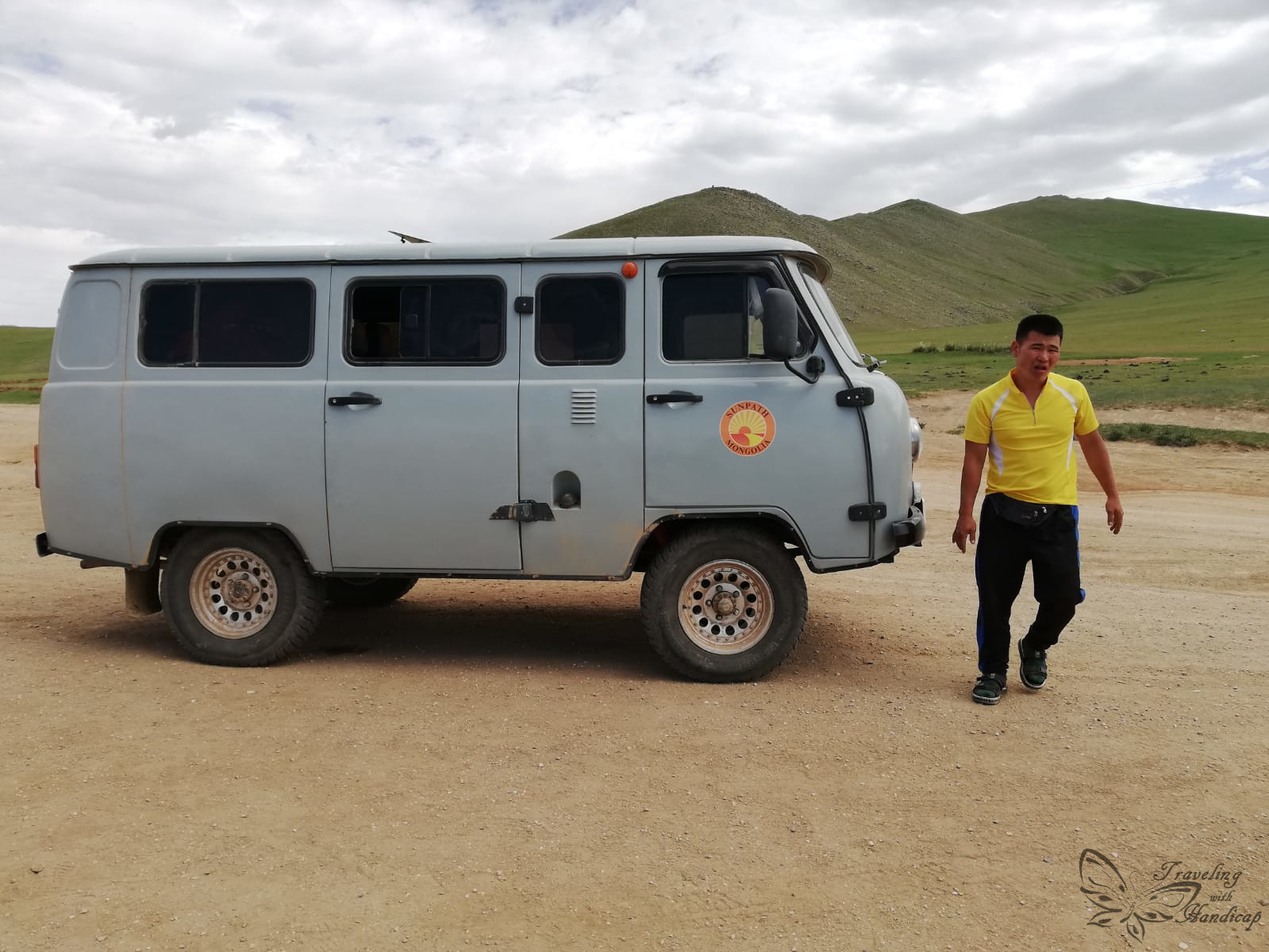
If you have any restrictions, I recommend to contact tour providers directly and book a private tour. Those tours are more expensive but will most likely happen in a better equipped car, with seatbelts and everything. Climbing sand-dunes or horseback riding might not be an option for you, though, I do not remember one natural sight which was not at least visible from the van. There are some smaller hotels within one or the other remote village, so if you outline your needs to a good tour provider, they will most likely find hotels which suit you better than Ger tents.
How to prepare for the tour
I recommend carrying your luggage in a backpack, as you can easily carry it, especially while walking over bumpy terrain. You will most likely not need everything you have in your backpack for a longer trip, try to leave some stuff at your hostel. Here is my recommended packing list for spring. During summer or winter, the amount of long versus short sleeves might differ. The recommendation corresponds to my 12-days tour of the Gobi Desert and Central Mongolia.
- Clothes
- Hiking Boots, Flip Flops, comfortable running shoes
- scarf or similar to cover your hair from dirt (on windy days)
- warm jacket (days and especially nights can get quite cold within the Gobi at higher altitudes)
- your own sleeping bag (if you have one) with comfort temperature below -3°
- long hiking pants which can be shortened
- short pants and t-shirts for 12 days
- a fleece jacked/jumper for mornings and evenings to sit outside
- light long shirts to cover your arms from the sun
- enough socks and underwear (I preferred comfortable hiking stuff)
- Cleaning / Bath
- baby-powder (for your hair, as you won’t be able to take any shower for a couple of days)
- sunscreen
- some crème to care for dry skin
- hand disinfectant and cleaning wipes
- plenty of toilet paper to cover 12 days (can be bought in a store in Ulaanbaatar)
- toothbrush and -paste
- quick-drying light towel
- Food / Drinks
- always take care to have plenty of water available in the car, you will need drinking water also for brushing your teeth or doing some minor cleanup of your body
- some nuts or snacks to have during long trips on bumpy land
- beer, nuts, or chips for the evenings (if stopping in a village on the way: get stocked up), I enjoyed the Golden Gobi
The Tour
We started in Ulaanbaatar, at the hostel, in the early morning. The first stop was a huge convenience store to buy some snacks and, far more important, toilet paper and cleaning wipes. What a funny coincidence, the two Germans who I met on the train from Beijing to Ulaanbaatar also joined this tour. Our tour guide asked us to call her “Vampy” since we couldn’t pronounce her Mongolian name correctly.
During our first day we drove towards the Mandalgobi, a lot of driving indeed. For a few hours, we drove along a paved road, stopping at stations for toilet breaks. The first outhouse experience made us develop a rating system for toilets. We agreed that the first person trying a toilet needs to rate it, from zero to five stars. Based on the rating, the others could decide if to use the outhouse, wait, or use nature. Back in Ulaanbaatar, I realized that many tourists developed a similar star rating.
Natural Sights and stops
Mandalgobi and White Stupa (close to Dalsandsadgad)
We had lunch at a roadhouse close to the main road in the town Mandalgobi. Shortly after this, the drivers drove inland, literally just on the ground. I never understood how the drivers were able to orient themselves within that countryside. It was flat and brown, not changing for hours. At one point, we saw some brown cloud in the far distance. Actually, it was a very heavy sandstorm. We had to stop and stay in the car as soon as it approached us, since the sand was sharp as hell while being blown over the skin. Vampy has never had experienced such a sandstorm before as well. So my first impression from the Gobi was literally mind-blowing.
Our natural sight of the day was the White Stupa (Tsagaan Suvarga), a natural formation which looks like ruins of an ancient city. The White Stupa is 30 m high at the highest point and 400 m long. It was dry when we visited, after rainy days, the water runs down the formation on many little waterfalls. The view was stunning, infinite vastness. No trees or higher plants anywhere. The Gobi has been the ground of an ocean millions of years ago. This is why all those hills are so smooth and abraded. Normal weather wouldn’t be able to do this.


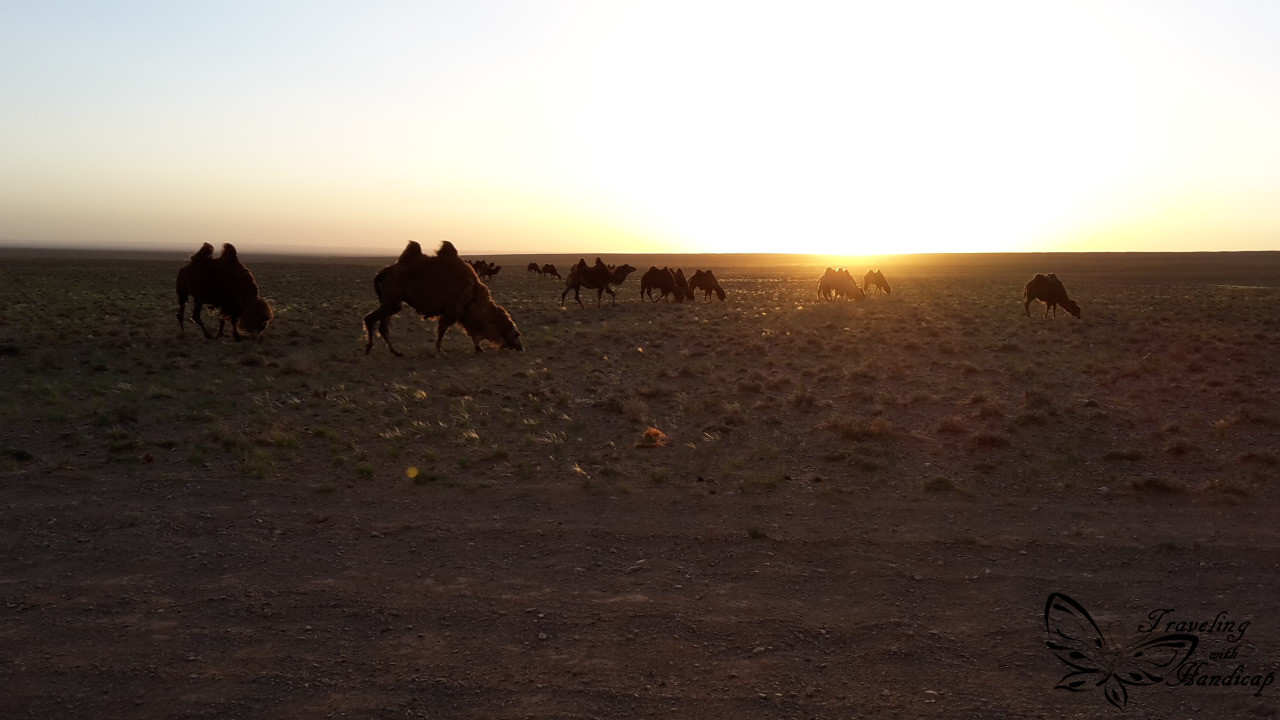
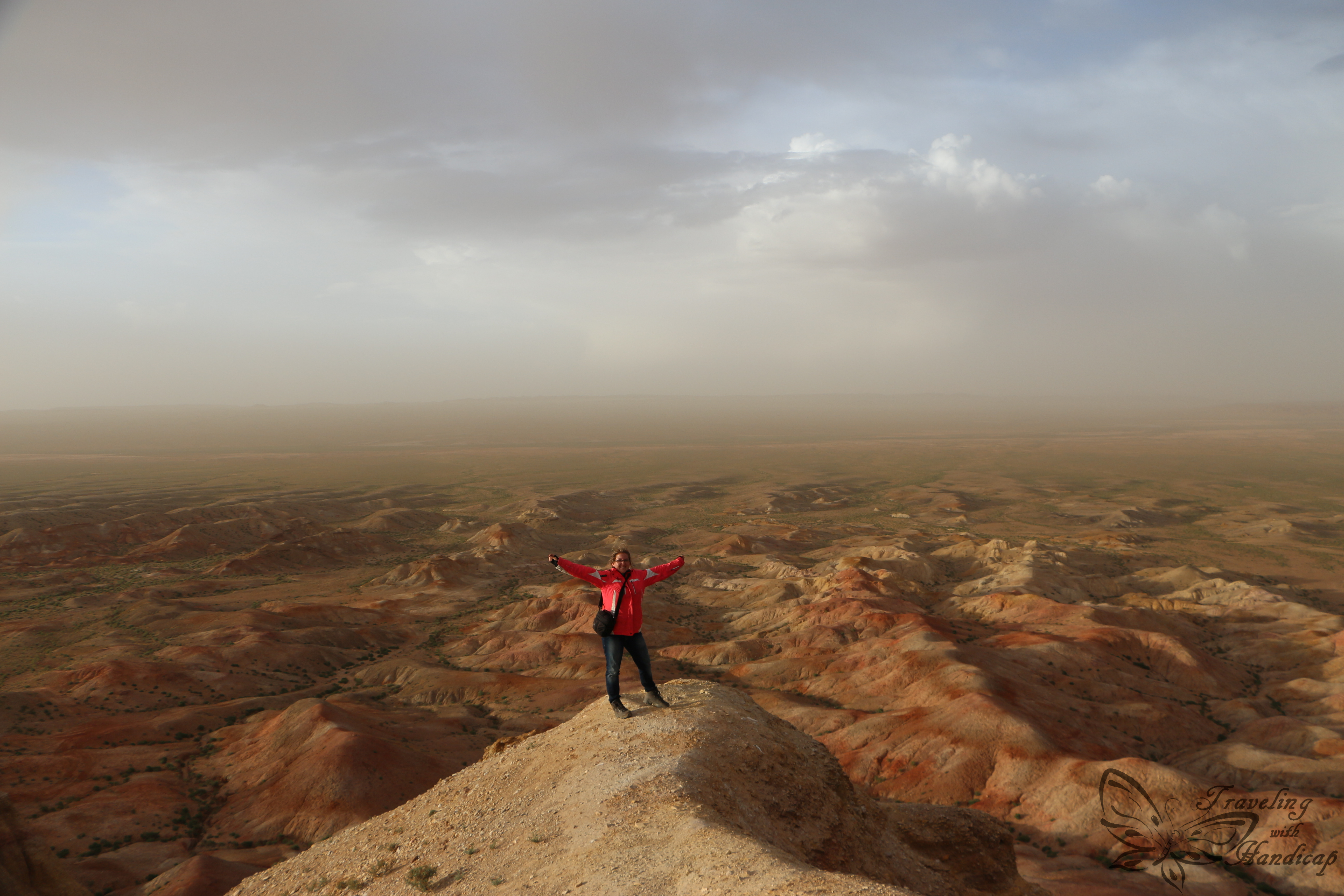
First Ger tent experience
After our White Stupa experience, we were on the way to our first Ger tent experience of the tour. Already close to sunset, we saw a herd of camels gazing around. We had to spot for such a magnificently peaceful gathering. We learned that all animals we see belong to some nomad families. Truly wild animals don’t approach people, they are too shy and only live in protected areas you may not to enter. We stayed with a Mongolian family close to the village of Dalsandsadgad. Honestly, I slept much better than expected before. Some nights were freezing, especially on higher altitudes in the Gobi. Therefore, I was quite happy about bringing my own sleeping bag.

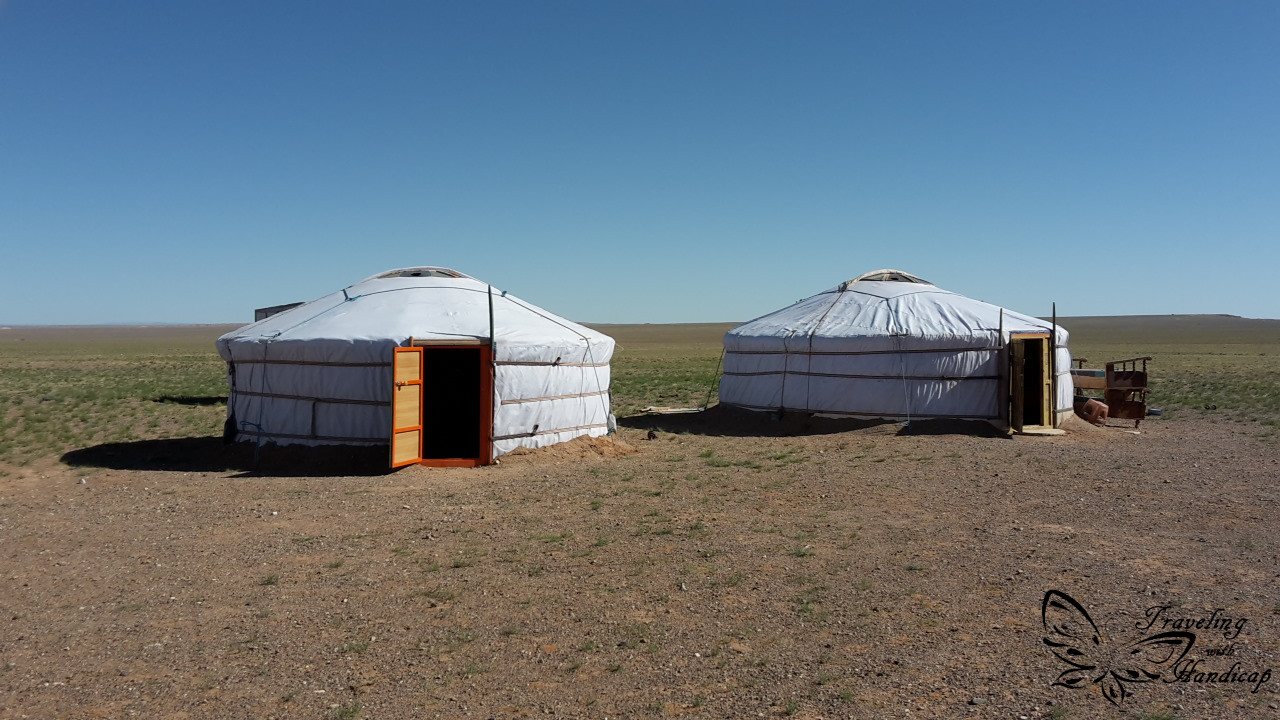
Yol Valley and some Mongolian rules
On our second day, we explored the Yol Valley within the north-east part of the Zuun Saikhan Mountain. We did not only walk into the valley, we even walked on the ice of a frozen waterfall and another part of a glacier. During this walk, Vampy tought us some Mongolian rules (of behaviour):
- take any (provided) things with your right hand
- the doors of Gers always point to southeast (to keep wind and as such the flies outside)
- don’t walk through the two middle wooden stakes since this would “bring something between the family-members”
- walk around the “Obo” (heap of stones) only clockwise, take a stone from the ground before starting a circle and put it on top of the Obo with your right hand when finishing the circle
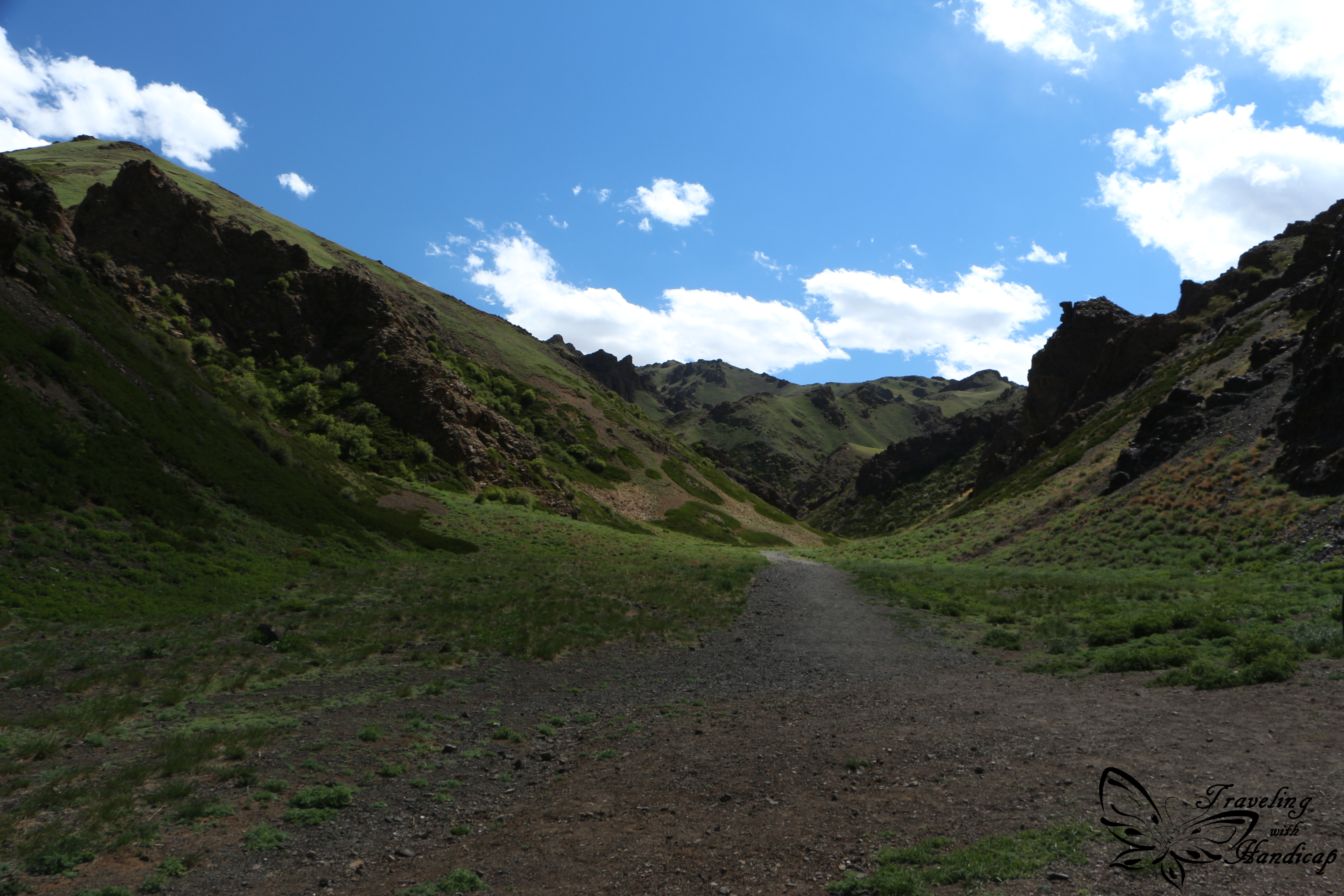
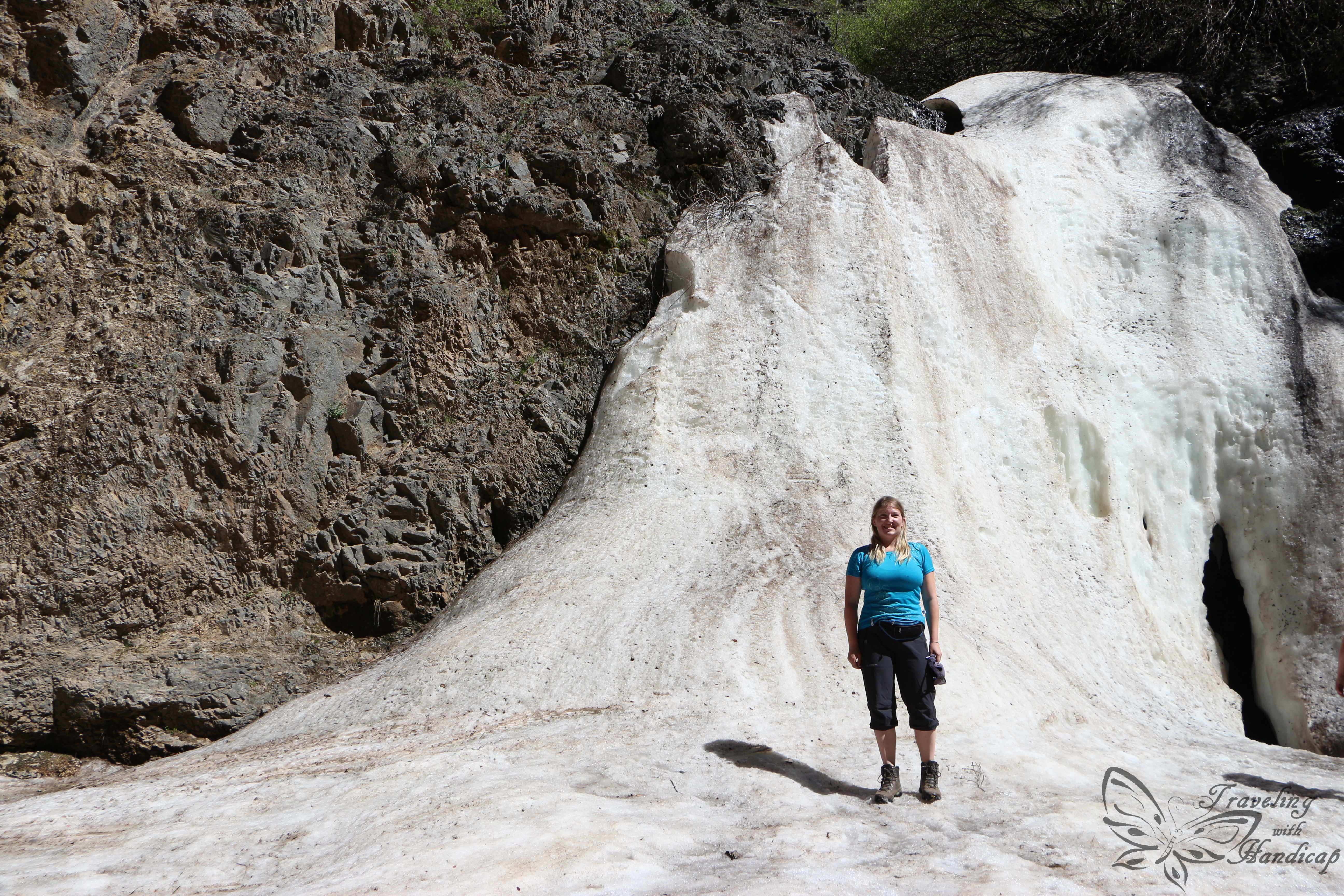
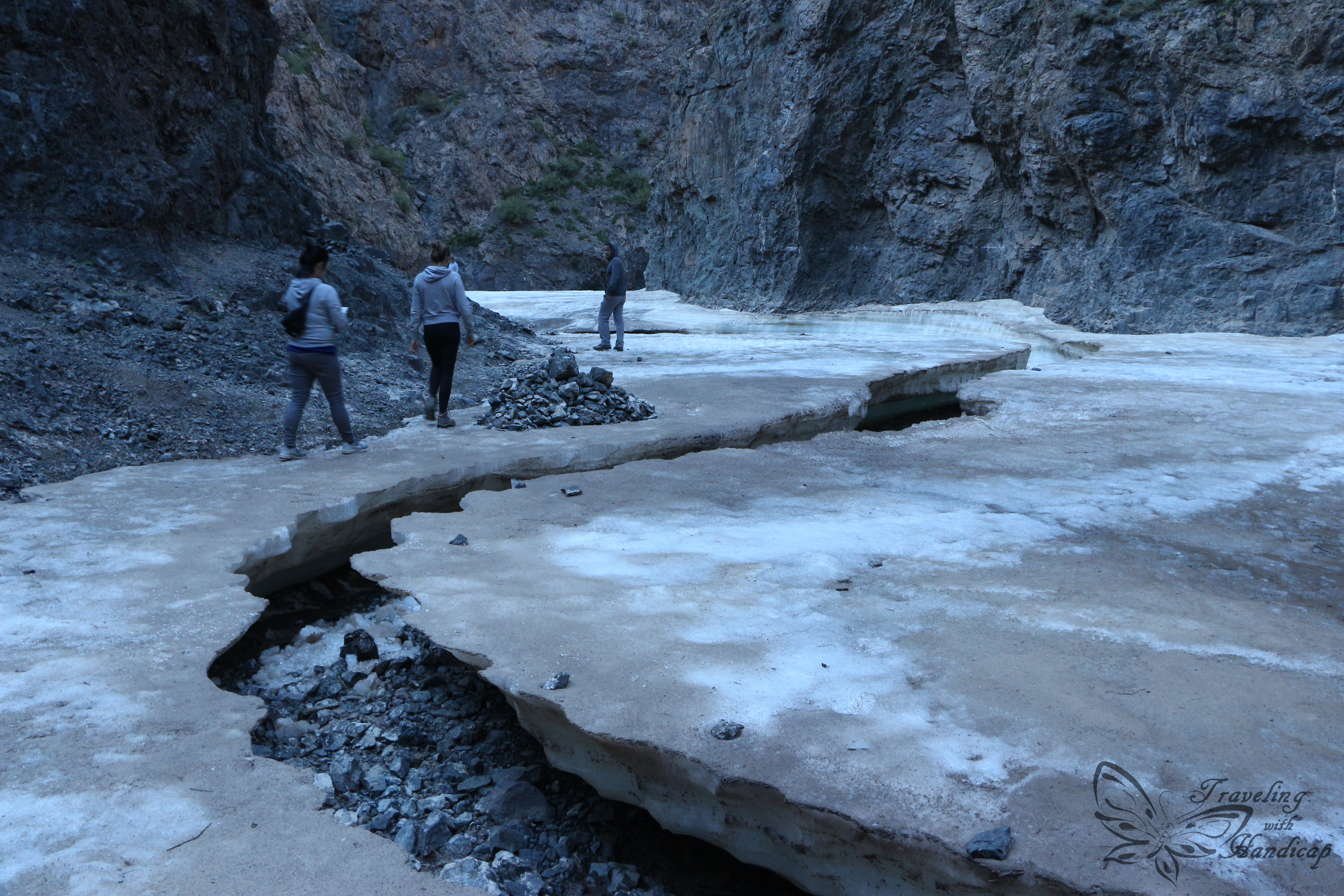
Sevrei Uul and Khongor Sand Dunes
From the Yol Valley we continued to Sevrei Uul, at the Khongor Sand Dunes. We stayed with an elderly Mongolian nomad who had many interesting stories to tell. We also played a fun Mongolian game with bone parts. I didn’t fully understand the game, but the Mongolians tried to beat each other with cheating tricks anyways. During the afternoon, we went on a camel ride. It’s ery special to ride a camel in pure nature, in the desert, without any fences, watching goats grazing. If you ride a camel for an hour as we did, move with the camel as you would do on a horse to avoide aching muscles.
Later in the evening, we climbed the sand dunes to watch the sunset from the top. I really struggled to climb up and asked to stay down at the cars. My group didn’t accept this, they tried to pull me up all the way to share the experience with them. What an experience, how cool are these people. The Gobi is a dry desert, there are no sand dunes except for the Khongor and surrounding ones. After watching the sunset, I tried out the singing skills of the sand dunes by sliding down on my butt. The air that is squeezed out of the sand sings.
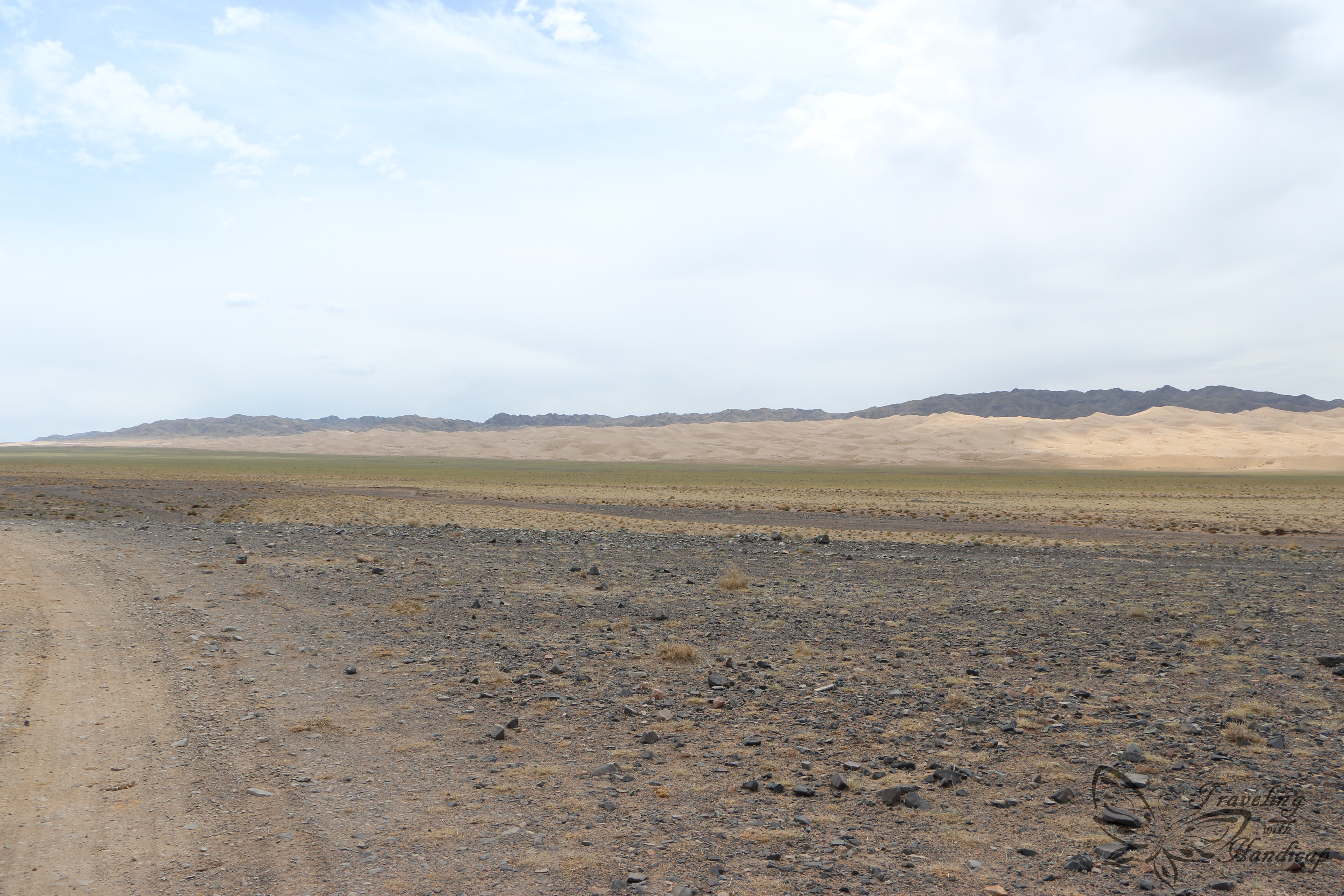
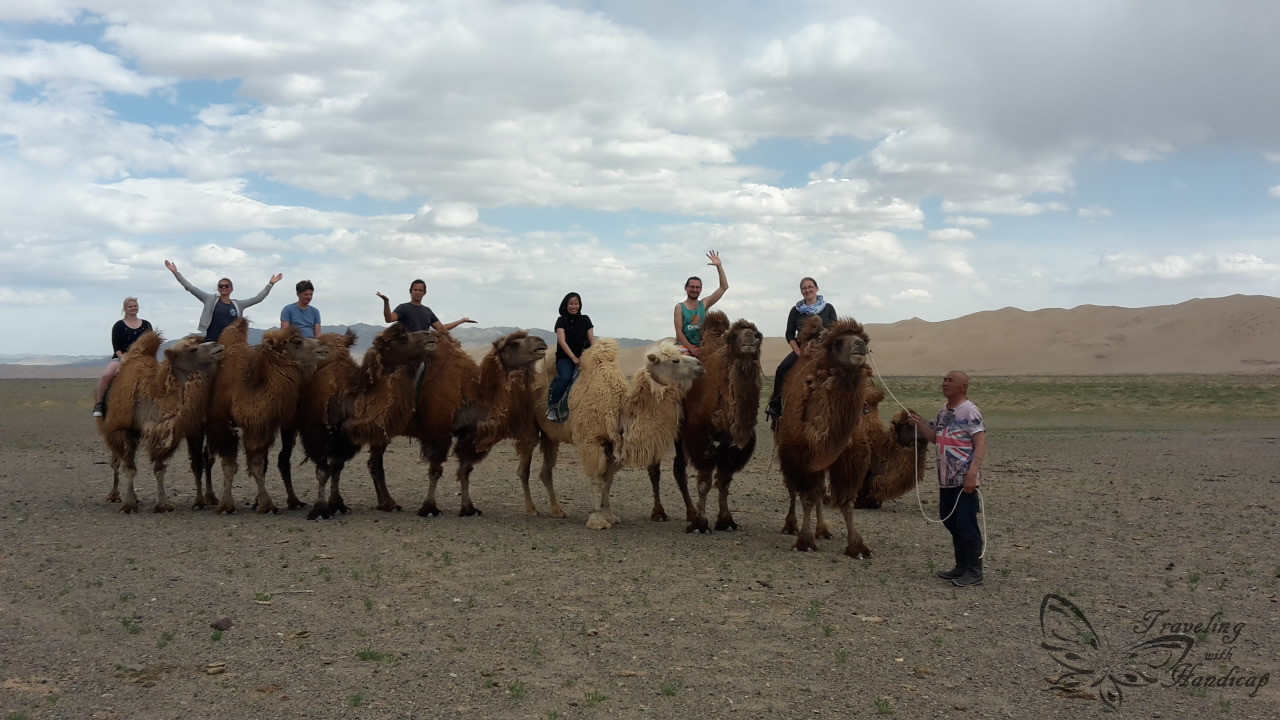

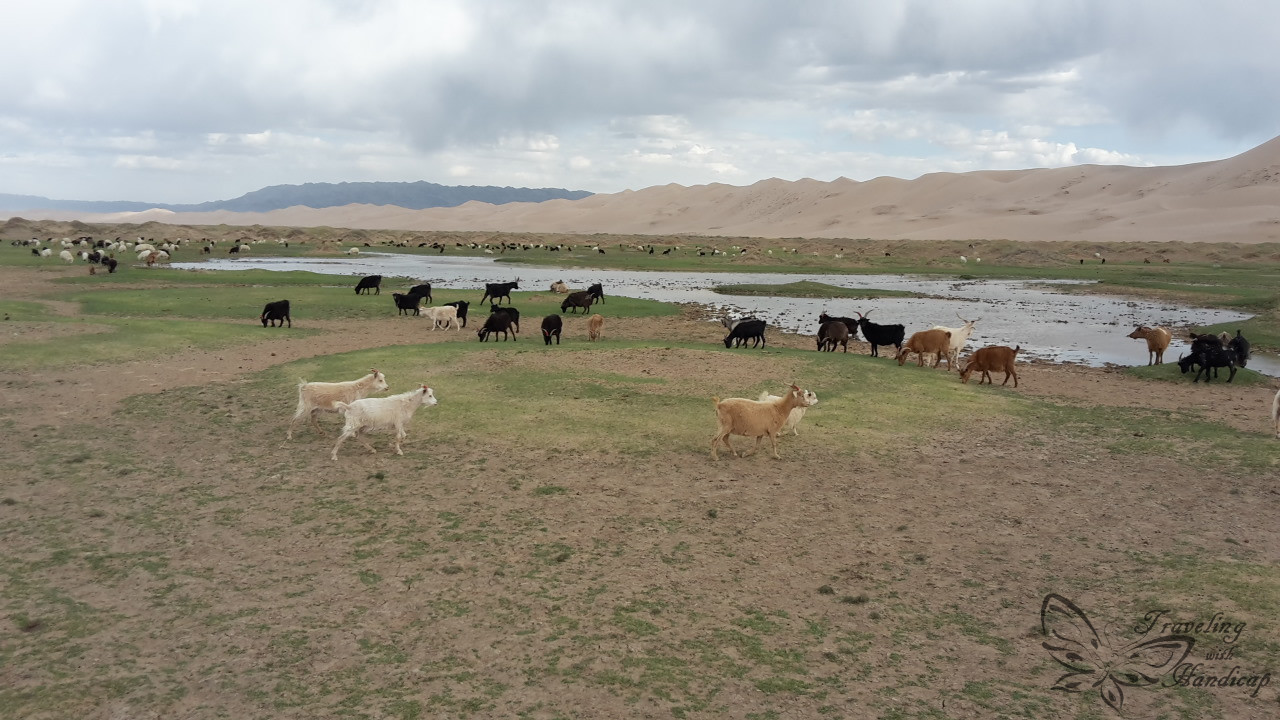

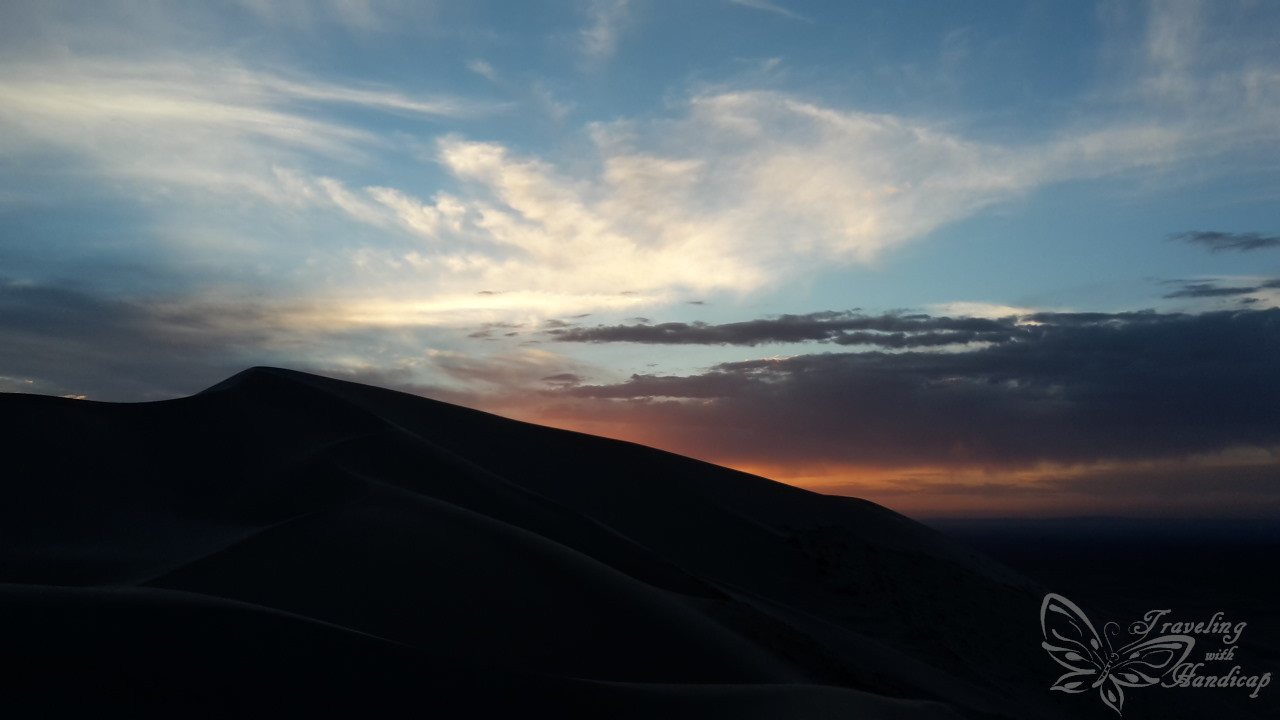

Bajandsag and Flaming Cliffs
Our third day started with another long drive on the dirt. We stopped at Bajandsag for lunch and learned how nomad kids attend school. Schools are located within bigger villages and kids from the village and from nomad people of the Aimag attend the school. Kids cannot ride to school every day, so they usually live in the village with their grandparents or other relatives taking care of them. During holidays they stay with their parents. This is why Mongolian nomads often become parents at a young age.
After lunch, we approached the Flaming Cliffs in the South Gobi. Plenty of (dinosaur) fossils have been found in the area around the cliffs. The nickname “flaming cliffs” is due to the orange-red rock of that mountain. The desert expands further south over time (due to winds) and brings the drought more and more to and into China. Therefore, Chinese scientists engage into populating the southern Gobi with trees which can stand the drought and reduce the expansion of the desert.
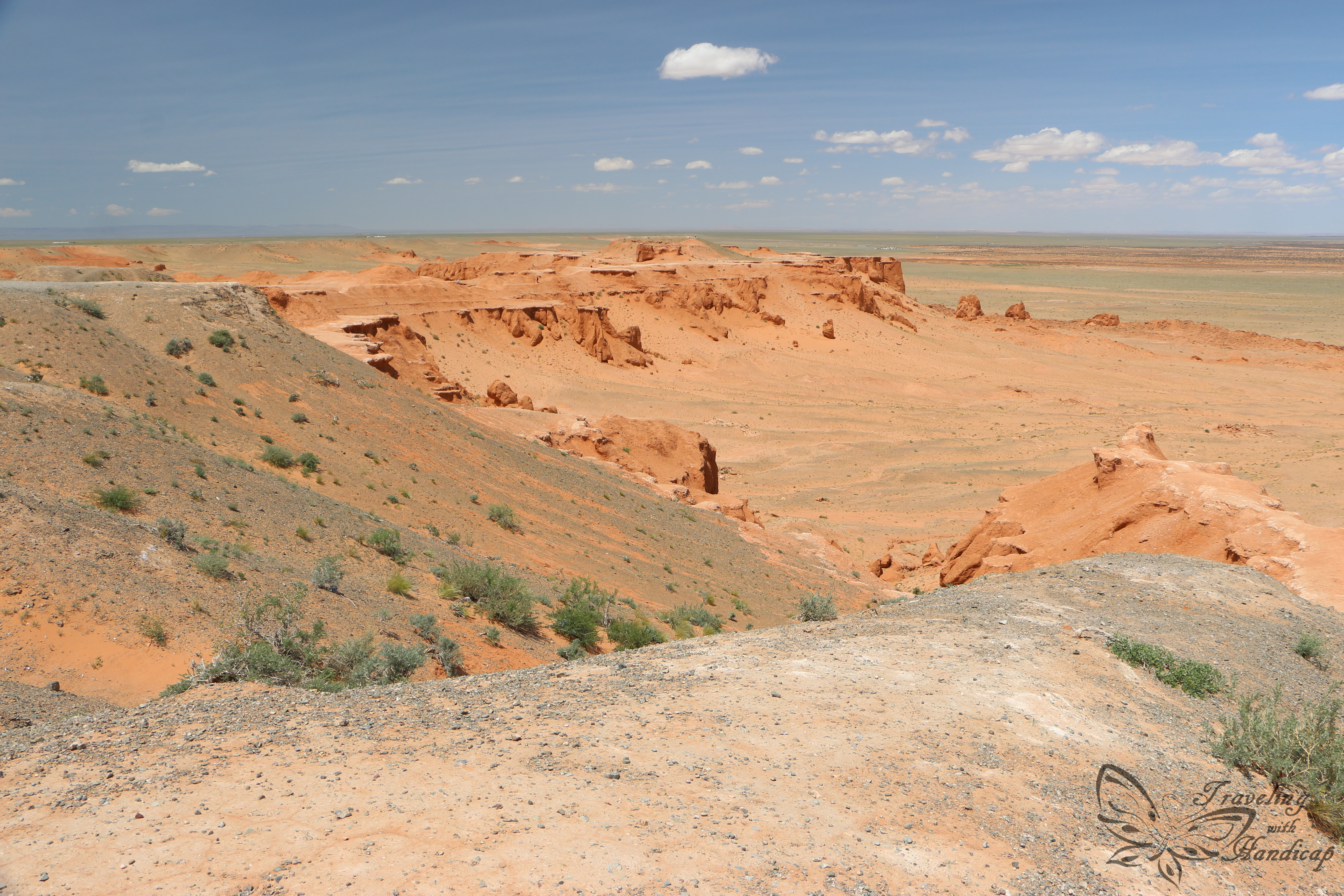


Ongiin Chiid
We spent our last day within the Gobi exploring the Ongi Monastery at the bank of the Ongiin River in the Middle Gobi province. It consits of 28 temples and other buildings. Most of them are collapsed, only a few were rebuilt. Before this monestary has been destroyed during the Stalinist purges in 1930s, about 1000 lamas lived here. The Russians tried to wipe out any religious practices within Mongolia, they managed to destroy monestaries but couldn’t swipe out people’s believes.
After visiting Ongiin Chiid, we had to say goodbye to three people of our group. They would go back to Ulaanbaatar with one sleepover somewhere on the direct way to Ulaanbaatar. We didn’t know each other before the tour, though, after sharing food, Gers, outhouses for 5 days, the farewell was quite difficult for all of us. As a group of four tourists, Vampy as our guide and the driver, we continued to explore Central Mongolia.


Nomad people living in the Gobi
I was so impressed by the energy and aura of these people living in the Gobi as nomads. They don’t live anywhere they find a spot, they rather have season dependent areas for their Gers and animals. During summertime, they stay within the flatter and less protected areas. During wintertime, they prefer to bring all their animals into more sheltered space. This is because winters can be really strong, snowstorms heavy, and animals might die from the lack of shelter and food. Losing some animals is a severe risk for the farmers as they completely rely on animals and their products.
Many nomad Mongolians also believe into shaman traditions, like connecting to their ancestors through a Shaman. We weren’t allowed to watch any Shaman practice. From the stories explained to us, it sounded much like “if the Shaman drinks more than too much alcohol, he behaves in a way as if”. Even though I am too much of a scientist to believe in shaman practices, I am still impressed by the beliefs and traditions of those people, connecting themselves to their ancestors and mother nature.

